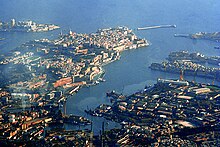Raid on Grand Harbour
Many of the two MAS-boat (Motoscafo armato silurante, torpedo-armed motorboat) crews and surviving Decima MAS men were killed when British Hurricane fighter aircraft attacked the MAS-boats on the morning of 26 July, along with two Macchi C.200 Saetta (Lightning) fighter escorts shot down in dogfights.
The interest of the Regia Marina in small boat warfare and other mezzi insidiosi, stealth and deceit, lay dormant between 1918 and the diplomatic crisis with Britain over the Second Italo-Ethiopian War 1935–1936.
On 28 September 1938, Supermarina ordered the I Flottiglia MAS (1st Torpedo Motorboat Flotilla), based at La Spezia, to establish a research department (the Sezione Armi Speciali (Special Weapons Section) from 1939.
[4] The Decima MAS MTMs got past a net barrage and rendezvoused near an islet in the mouth of Souda Bay, the MTM pilots using oars to move quietly.
A bridge spanned the gap, resting on a central pylon and a steel torpedo net had been suspended from it down to the seabed.
The 6-pounders fired special anti-flash ammunition, to avoid blinding the gun-layers at night but concealing the flash produced huge clouds of smoke.
[13] On 24 June, Convoy GM 1 from Operation Substance arrived at Malta, guaranteeing that Grand Harbour would contain plenty of targets.
Moccagatta got the boats moving faster than planned, the damaged MTM dropped back and had to be scuttled, the pilot, Montanari, going aboard MAS-452.
The first raid by the Regia Aeronautica at 01:45 did not appear and just after 02:00 on 26 July Decima MAS reached Point B, 4.3 nmi (8 km) north of Valletta, not the planned arrival at 01:34.
The MAS stopped and the eight MTM, led by Giobbe in the MTS, sailed southwards towards Valletta, in line-ahead at 5 kn (9.3 km/h; 5.8 mph), the maximum speed of the MTL, which reduced the wakes and noise of the boat engines.
At 22:30 hours on 25 July, 502 RAF Radar station, at Fort Madliena, detected a strong echo 39 nmi (72 km) to the north-east, the defences were alerted and gun crews closed up.
The maiali were launched but this took a long time and the Italians found that the maiale for Marsaxxlox Harbour was down by the stern, probably because of the earlier collision between the MTL and MAS-451.
Because of the approaching dawn and the air raid diversion, cutting the St Elmo net could not be delayed beyond 04:30, leaving Tesei 45 minutes to plant his explosive charge.
Tesei began his approach but there was an offshore westerly current and the maiale had drifted eastwards during the delay, considerably lengthening the journey beyond 04:30.
At 04:30, the MTM pilots were still waiting for the explosion and Giobbe told Frassetto to destroy the net, with Carabelli to back him up in case of problems.
The two boats headed southwards to reach the St Elmo headland but the pilots were surprised to find themselves off Fort Ricasoli, well to the east.
The blast of the double explosion on the surface of the sea, rather than at depth, destroyed the net and brought down one of the bridge spans, filling the passage with wreckage, making an even worse obstacle.
In the fire, smoke and water splashes, four pilots managed to steer northwards into the dark, benefiting from a light sea mist.
Not long after 05:00, dawn having broken, Giobbe ordered the MTL to withdraw and he went at full speed towards the MAS at Point B. Bosio stopped his MTM about 4,900 ft (1,500 m), north-west of Fort St Elmo, to rally the MTMs but only Zaniboni appeared.
[19] Capriotti steered slowly through the mist to the south-west and eventually saw that he was close to the shore, west of Fort St Elmo.
The captain, Parodi, his helmsman, Moccagatta, Giobbe, Falcomata (surgeon), Montanari (pilot of the scuttled MTM), Constantini and Zocchi (MTS crew), were killed.
[21] The eleven survivors, fearing that MAS-452 was about to founder, got into the MTS, sped towards Sicily and rendezvoused with Diana, which was waiting for the returning boats off Cape Passero.
A Hurricane was shot down by a Saetta, the MAS was set on fire, three more of the crew members were killed and nine survivors abandoned ship, which blew up at about 06:40.
It might be that the small wave shot at by "G" gun at Fort St Elmo, between Carabelli's explosion and the lighting of the searchlights, was Tesei.
Costa and Baria swam ashore about 3 mi (4.8 km) north-west of Valletta and surrendered, their maiale being salvaged later by the British.
[8] In 1957, the British naval official historian, Stephen Roskill, wrote that the harbour defences were alert and that the attacking force was destroyed, having achieved nothing.
The British Ultra code-breakers gave a warning of the attack, the approach of Diana was revealed by radar and mechanical failures blighted the mission.
[25] In 2003, Richard Woodman wrote that the "bold Italian plan had entirely and literally misfired: not only had they rendered...the entrance completely impassable but their approach had been detected and monitored by radar"; he called the attack an abject failure.
[26] In 2009, Vincent O'Hara called the attack a fiasco because the collapsing of the bridge created an obstacle greater than the torpedo nets used to close the channel.
[21] The British lost one Hurricane fighter and captured MAS-452, which was towed in by the trawler Jade, a drifting MTM and Costa's maiale.











